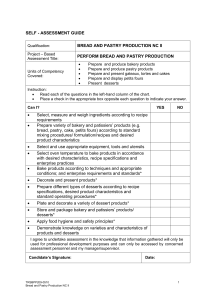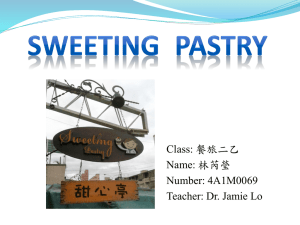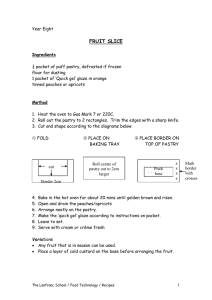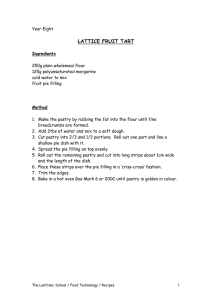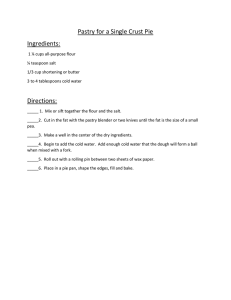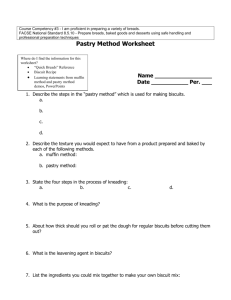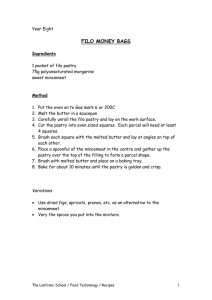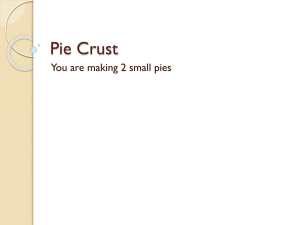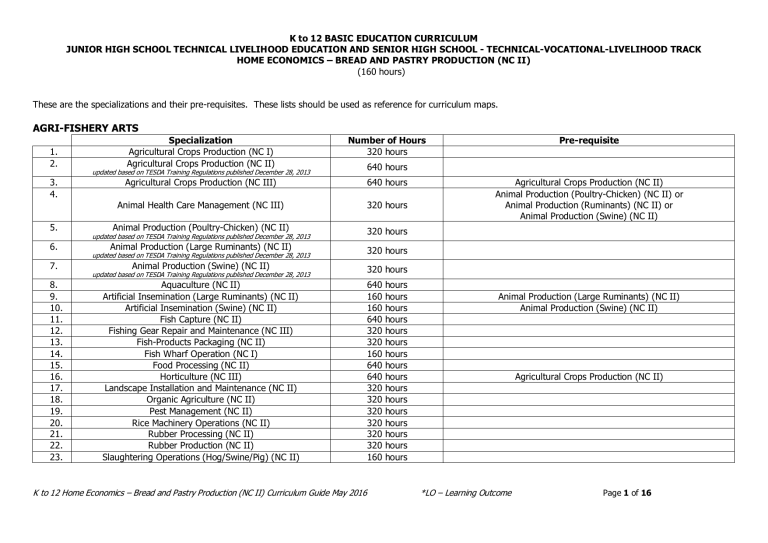
K to 12 BASIC EDUCATION CURRICULUM JUNIOR HIGH SCHOOL TECHNICAL LIVELIHOOD EDUCATION AND SENIOR HIGH SCHOOL - TECHNICAL-VOCATIONAL-LIVELIHOOD TRACK HOME ECONOMICS – BREAD AND PASTRY PRODUCTION (NC II) (160 hours) These are the specializations and their pre-requisites. These lists should be used as reference for curriculum maps. AGRI-FISHERY ARTS 1. 2. 3. 4. 5. 6. 7. 8. 9. 10. 11. 12. 13. 14. 15. 16. 17. 18. 19. 20. 21. 22. 23. Specialization Agricultural Crops Production (NC I) Agricultural Crops Production (NC II) Number of Hours 320 hours Agricultural Crops Production (NC III) 640 hours Animal Health Care Management (NC III) 320 hours Animal Production (Poultry-Chicken) (NC II) 320 hours Animal Production (Large Ruminants) (NC II) 320 hours Animal Production (Swine) (NC II) 320 hours updated based on TESDA Training Regulations published December 28, 2013 updated based on TESDA Training Regulations published December 28, 2013 updated based on TESDA Training Regulations published December 28, 2013 updated based on TESDA Training Regulations published December 28, 2013 Aquaculture (NC II) Artificial Insemination (Large Ruminants) (NC II) Artificial Insemination (Swine) (NC II) Fish Capture (NC II) Fishing Gear Repair and Maintenance (NC III) Fish-Products Packaging (NC II) Fish Wharf Operation (NC I) Food Processing (NC II) Horticulture (NC III) Landscape Installation and Maintenance (NC II) Organic Agriculture (NC II) Pest Management (NC II) Rice Machinery Operations (NC II) Rubber Processing (NC II) Rubber Production (NC II) Slaughtering Operations (Hog/Swine/Pig) (NC II) K to 12 Home Economics – Bread and Pastry Production (NC II) Curriculum Guide May 2016 Pre-requisite 640 hours 640 160 160 640 320 320 160 640 640 320 320 320 320 320 320 160 hours hours hours hours hours hours hours hours hours hours hours hours hours hours hours hours Agricultural Crops Production (NC II) Animal Production (Poultry-Chicken) (NC II) or Animal Production (Ruminants) (NC II) or Animal Production (Swine) (NC II) Animal Production (Large Ruminants) (NC II) Animal Production (Swine) (NC II) Agricultural Crops Production (NC II) *LO – Learning Outcome Page 1 of 16 K to 12 BASIC EDUCATION CURRICULUM JUNIOR HIGH SCHOOL TECHNICAL LIVELIHOOD EDUCATION AND SENIOR HIGH SCHOOL - TECHNICAL-VOCATIONAL-LIVELIHOOD TRACK HOME ECONOMICS – BREAD AND PASTRY PRODUCTION (NC II) (160 hours) HOME ECONOMICS Specialization Number of Hours 160 hours 320 hours 320 hours 160 hours 160 hours 640 hours 320 hours 320 hours 320 hours 320 hours 640 hours 1. 2. 3. 4. 5. 6. 7. 8. 9. 10. 11. 12. Attractions and Theme Parks Operations with Ecotourism (NC II) Barbering (NC II) Bartending (NC II) Beauty/Nail Care (NC II) Bread and Pastry Production (NC II) Caregiving (NC II) Commercial Cooking (NC III) Cookery (NC II) Dressmaking (NC II) Events Management Services (NC III) Fashion Design (Apparel) (NC III) Food and Beverage Services (NC II) 13. 14. 15. 16. 17. 18. 19. 20. Front Office Services (NC II) Hairdressing (NC II) Hairdressing (NC III) Handicraft (Basketry, Macrame) (Non-NC) Handicraft (Fashion Accessories, Paper Craft) (Non-NC) Handicraft (Needlecraft) (Non-NC) Handicraft (Woodcraft, Leathercraft) (Non-NC) Housekeeping (NC II) 160 320 640 160 160 160 160 21. 22. 23. 24. 25. Local Guiding Services (NC II) Tailoring (NC II) Tourism Promotion Services (NC II) Travel Services (NC II) Wellness Massage (NC II) 160 320 160 160 160 updated based on TESDA Training Regulations published December 28, 2013 updated based on TESDA Training Regulations published December 28, 2013 K to 12 Home Economics – Bread and Pastry Production (NC II) Curriculum Guide May 2016 Pre-requisite Cookery (NC II) Dressmaking (NC II) or Tailoring (NC II) 160 hours hours hours hours hours hours hours hours Hairdressing (NC II) 160 hours hours hours hours hours hours *LO – Learning Outcome Page 2 of 16 K to 12 BASIC EDUCATION CURRICULUM JUNIOR HIGH SCHOOL TECHNICAL LIVELIHOOD EDUCATION AND SENIOR HIGH SCHOOL - TECHNICAL-VOCATIONAL-LIVELIHOOD TRACK HOME ECONOMICS – BREAD AND PASTRY PRODUCTION (NC II) (160 hours) INDUSTRIAL ARTS 1. Specialization Number of Hours Automotive Servicing (NC I) 640 hours updated based on TESDA Training Regulations published December 28, 2013 2. 3. 4. 5. 6. 7. 8. 9. 10. Automotive Servicing (NC II) Carpentry (NC II) Carpentry (NC III) Construction Painting (NC II) Domestic Refrigeration and Air-conditioning (DOMRAC) Servicing (NC II) Driving (NC II) Electrical Installation and Maintenance (NC II) Electric Power Distribution Line Construction (NC II) Electronic Products Assembly and Servicing (NC II) 640 640 320 160 640 160 640 320 11. 12. 13. 14. 15. 16. 17. 18. 19. 20. 21. 22. Furniture Making (Finishing) (NC II) Instrumentation and Control Servicing (NC II) Gas Metal Arc Welding (GMAW) (NC II) Gas Tungsten Arc Welding (GTAW) (NC II) Machining (NC I) Machining (NC II) Masonry (NC II) Mechatronics Servicing (NC II) Motorcycle/Small Engine Servicing (NC II) Plumbing (NC I) Plumbing (NC II) Refrigeration and Air-Conditioning (Packaged Air-Conditioning Unit [PACU]/Commercial Refrigeration Equipment [CRE]) Servicing (NC III) Shielded Metal Arc Welding (NC I) Shielded Metal Arc Welding (NC II) Tile Setting (NC II) Transmission Line Installation and Maintenance (NC II) 640 320 320 320 640 640 320 320 320 320 320 23. 24. 25. 26. updated based on TESDA Training Regulations published December 28, 2013 K to 12 Home Economics – Bread and Pastry Production (NC II) Curriculum Guide May 2016 hours hours hours hours hours hours hours hours Pre-requisite Automotive Servicing (NC I) Carpentry (NC II) Electrical Installation and Maintenance (NC II) 640 hours hours hours hours hours hours hours hours hours hours hours hours 640 hours 320 320 320 640 hours hours hours hours Electronic Products Assembly and Servicing (EPAS) (NC II) Shielded Metal Arc Welding (SMAW) (NC II) Shielded Metal Arc Welding (GMAW) (NC II) Machining (NC I) Electronic Products Assembly and Servicing (EPAS) (NC II) Plumbing (NC I) Domestic Refrigeration and Air-conditioning (DOMRAC) Servicing (NC II) Shielded Metal Arc Welding (NC I) Electrical Installation and Maintenance (NC II) *LO – Learning Outcome Page 3 of 16 K to 12 BASIC EDUCATION CURRICULUM JUNIOR HIGH SCHOOL TECHNICAL LIVELIHOOD EDUCATION AND SENIOR HIGH SCHOOL - TECHNICAL-VOCATIONAL-LIVELIHOOD TRACK HOME ECONOMICS – BREAD AND PASTRY PRODUCTION (NC II) (160 hours) INFORMATION, COMMUNICATIONS AND TECHNOLOGY (ICT) Specialization 1. 2. 3. 4. 5. 6. 7. 8. 9. 10. 11. 12. Animation (NC II) Broadband Installation (Fixed Wireless Systems) (NC II) Computer Programming (.Net Technology) (NC III) updated based on TESDA Training Regulations published December 28, 2013 Number of Hours 320 hours 160 hours 320 hours Computer Programming (Oracle Database) (NC III) 320 hours Computer Systems Servicing (NC II) 640 hours updated based on TESDA Training Regulations published December 28, 2013 updated based on TESDA Training Regulations published December 28, 2007 Contact Center Services (NC II) Illustration (NC II) Medical Transcription (NC II) Technical Drafting (NC II) Telecom OSP and Subscriber Line Installation (Copper Cable/POTS and DSL) (NC II) Telecom OSP Installation (Fiber Optic Cable) (NC II) K to 12 Home Economics – Bread and Pastry Production (NC II) Curriculum Guide May 2016 Computer Systems Servicing (NC II) 320 hours Computer Programming (Java) (NC III) updated based on TESDA Training Regulations published December 28, 2013 Pre-requisite 320 320 320 320 hours hours hours hours 320 hours Computer Systems Servicing (NC II) 160 hours Computer Systems Servicing (NC II) *LO – Learning Outcome Page 4 of 16 K to 12 BASIC EDUCATION CURRICULUM JUNIOR HIGH SCHOOL TECHNICAL LIVELIHOOD EDUCATION AND SENIOR HIGH SCHOOL - TECHNICAL-VOCATIONAL-LIVELIHOOD TRACK HOME ECONOMICS – BREAD AND PASTRY PRODUCTION (NC II) (160 hours) Course Description: This curriculum guide on Bread and Pastry Production course leads to National Certificate Level II (NC II). This course is designed for high school student to develop knowledge, skills, and attitude to perform the tasks on Bread and Pastry Production. It covers core competencies namely: 1) prepare and produce bakery products; 2) prepare and produce pastry products; 3) prepare and present gateau, tortes and cakes; 4) prepare and display petit fours and 5) present deserts. The preliminaries of this specialization course includes the following: 1) Explain core concepts in bread & pastry production; 2) Discuss the relevance of the course 3) Explore on opportunities for a Baker or Commis as a career. CONTENT Introduction 1. Basic concepts in bread and pastry production 2. Relevance of the course 3. Career opportunities CONTENT STANDARD The learners demonstrate an understanding of the core concepts and theories in bread and pastry production PERFORMANCE STANDARD The learners independently demonstrate core competencies in bread and pastry production as prescribed in the TESDA Training Regulation The 1. 2. 3. LEARNING COMPETENCIES learners: explain core concepts in bread and pastry production discuss the relevance of the course explore opportunities in bread and pastry production CODE Quarter 1 Lesson 1: PREPARE AND PRODUCE BAKERY PRODUCTS 1. Accurate measurement of The learners demonstrate an The learners independently LO 1. Prepare bakery products TLE_HEBP9ingredients understanding of the core demonstrate core 1.1 Select, measure and weigh required 12PB-Ia-f-1 2. Baking ingredients and its concepts and theories in bread competencies in preparing and ingredients according to recipe or substitution and pastry production producing bakery products production requirements 3. Types, kinds, and classification 1.2 Prepare a variety of bakery products of bakery products according to standard mixing 4. Mixing procedures/ formulation/ recipes and procedures/formulation/ desired product characteristics recipes, and desired product 1.3 Use appropriate equipment characteristics of various according to required bakery bakery products products and standard operating 5. Baking techniques, appropriate procedures conditions and enterprise 1.4 Bake bakery products according to requirements and standards techniques and appropriate 6. Temperature ranges in bakery conditions products 1.5 Select required oven temperature to 7. Suggested projects: bake goods in accordance with the 7.1. Dinner roll desired characteristics, standards 7.2. Pan de sal recipe specifications K to 12 Home Economics – Bread and Pastry Production (NC II) Curriculum Guide May 2016 *LO – Learning Outcome Page 5 of 16 K to 12 BASIC EDUCATION CURRICULUM JUNIOR HIGH SCHOOL TECHNICAL LIVELIHOOD EDUCATION AND SENIOR HIGH SCHOOL - TECHNICAL-VOCATIONAL-LIVELIHOOD TRACK HOME ECONOMICS – BREAD AND PASTRY PRODUCTION (NC II) (160 hours) CONTENT CONTENT STANDARD PERFORMANCE STANDARD LEARNING COMPETENCIES CODE 7.3. Cinnamon roll 7.4. Ensaymada 7.5. Pan de coco Quarter 2 LESSON 1: PREPARE AND PRODUCE PASTRY PRODUCTS (PP) 1. Culinary and technical terms The learner demonstrates The learner demonstrate LO 1. Prepare pastry products TLE_HEBP9related to pastry products understanding of the basic competencies in preparing and 1.1. Select, measure and weigh required 12PP-IIa-g-4 2. Ratio of ingredients required to concept and underlying producing pastry products ingredients according to recipe or produce a balance formula theories in preparing and production requirements and 3. Correct proportion control, producing pastry products established standards and yields, weights and sizes for procedures profitability 1.2. Prepare variety of pastry products 4. Types, kinds, and classification according to standard mixing of pastry products procedures/formulation/ recipes and 5. Mixing desired product characteristics procedures/formulation/recipes 1.3. Use appropriate equipment according and desired product to required pastry products and characteristics of various standard operating procedures pastry products 1.4. Bake pastry products according to 6. Baking tools, equipment, and techniques and appropriate their uses and functions conditions; and enterprise 7. Baking techniques appropriate requirement and standards conditions, and enterprise 1.5. Select required oven temperature to requirements and standards bake goods in accordance with the 8. Temperature ranges in baking desired characteristics, standards pastry products recipe specifications and enterprise 9. Occupational health and safety practices 10. Suggested projects: 10.1 Pies - Pineapple pie - Buko pie - Egg pie 10.2 Pizza 10.3 Empanada 10.4 Tart 10.5 Etc. K to 12 Home Economics – Bread and Pastry Production (NC II) Curriculum Guide May 2016 *LO – Learning Outcome Page 6 of 16 K to 12 BASIC EDUCATION CURRICULUM JUNIOR HIGH SCHOOL TECHNICAL LIVELIHOOD EDUCATION AND SENIOR HIGH SCHOOL - TECHNICAL-VOCATIONAL-LIVELIHOOD TRACK HOME ECONOMICS – BREAD AND PASTRY PRODUCTION (NC II) (160 hours) CONTENT CONTENT STANDARD PERFORMANCE STANDARD LEARNING COMPETENCIES CODE 11. Types and classifications of LO 2. Decorate and present TLE_HEBP9fillings, coatings/icing and Pastry products 12PP-IIh-i-5 glazes 2.1 Prepare a variety of fillings and 12. Regular and special fillings and coating/icing, glazes and decorations coating/icing, glazes and for pastry products according to decorations standard recipes, enterprise standards 13. Decorative techniques and and/or customer preferences rules for garnishing 2.2 Fill and decorate pastry products, 14. The tools and materials in where required and appropriate, in decorating, finishing and accordance with standard recipes presenting and/or enterprise standards and 15. Standards and procedures in customer preferences decorating pastry products 2.3 Finish pastry products according to 16. Occupational Health and desired product characteristics Safety 2.4 Present baked pastry products 17. Standards and procedures in according to established standards finishing pastry products and procedures 18. Plating and presenting pastry products 19. Shelf-life of pastry products LO 3. Store pastry products TLE_HEBP920. Standards and procedures in 3.1 Store pastry products according to 12PP-IIj-6 storing pastry products established standards and 21. Different kinds of packaging procedures materials to be used 3.2 Select packaging appropriate for the 22. Standards and procedures in preservation of product freshness packaging pastry product and eating characteristics Quarter 3 LESSON 1: PREPARE AND PRESENT GATEAUX, TORTES AND CAKES (TC) 1. Culinary terms related to The learner demonstrates The learner demonstrate LO 1. Prepare sponge and cakes TLE_HEBP9sponge and cakes understanding of the core competencies in preparing and 1.1 Select, measure and weigh 12TC-IIIa-f-7 2. How to measure ingredients concept and underlying presenting gateaux, tortes and ingredients according to recipe 3. Correct proportion control, theories in preparing and cakes requirements, enterprise practices yields, weights and sizes for presenting gateaux, tortes and and customer practices profitability cakes 1.2 Select required oven temperature to 4. Main ingredients used for bake goods in accordance with variety of sponge and cakes desired characteristics, standard K to 12 Home Economics – Bread and Pastry Production (NC II) Curriculum Guide May 2016 *LO – Learning Outcome Page 7 of 16 5. 6. 7. 8. 9. 10. 11. 12. 13. 14. 15. 16. K to 12 BASIC EDUCATION CURRICULUM JUNIOR HIGH SCHOOL TECHNICAL LIVELIHOOD EDUCATION AND SENIOR HIGH SCHOOL - TECHNICAL-VOCATIONAL-LIVELIHOOD TRACK HOME ECONOMICS – BREAD AND PASTRY PRODUCTION (NC II) (160 hours) CONTENT CONTENT STANDARD PERFORMANCE STANDARD LEARNING COMPETENCIES CODE Specific temperature used for recipe specifications and enterprise different types of sponge and practices cakes 1.3 Prepare sponges and cakes according Pre-heating the oven to recipe specifications, techniques Classification of the different and conditions and desired product types of sponge and cakes characteristics Mixing methods used for 1.4 Use appropriate equipment according variety of sponge and cakes to required pastry and bakery Required equipment and products and standard operating materials for sponge and cakes procedures Recipe specifications, 1.6 Cool sponges and cakes according to techniques and conditions and established standards and desired product characteristics procedures Cooling temperature of sponge and cakes Suggested projects: Batter cake with butter icing Sponge cake with butter cream filling and icing Chiffon cake with boiled icing or fondant icing Chocolate cake 17. Identification of fillings appropriate in a specific cakes 18. Identification of the required consistency and appropriate flavor of fillings 19. Filling and assembling cakes according to the standard recipe specifications 20. Classification of coatings and sidings based on the required recipe specifications and product characteristics K to 12 Home Economics – Bread and Pastry Production (NC II) Curriculum Guide May 2016 LO 2. Prepare and use fillings 2.1 Prepare and select fillings in accordance with required consistency and appropriate flavors 2.2 Fill and assemble slice or layer sponges and cakes according to standard recipe specifications, enterprise practice and customer preferences 2.3 Select coatings and sidings according to the product characteristics and required recipe specification *LO – Learning Outcome TLE_HEBP912TC-IIIg-8 Page 8 of 16 K to 12 BASIC EDUCATION CURRICULUM JUNIOR HIGH SCHOOL TECHNICAL LIVELIHOOD EDUCATION AND SENIOR HIGH SCHOOL - TECHNICAL-VOCATIONAL-LIVELIHOOD TRACK HOME ECONOMICS – BREAD AND PASTRY PRODUCTION (NC II) (160 hours) CONTENT CONTENT STANDARD PERFORMANCE STANDARD LEARNING COMPETENCIES CODE 21. Identification of specific LO 3. Decorate cakes TLE_HEBP9decorations appropriate for 3.1 Decorate sponges and cakes suited to 12TC-IIIh-i-9 sponge and cakes the product and occasion and in 22. Identification of standard accordance with standard recipes and recipes of icings and enterprise practices decorations for sponge and 3.2 Use suitable icings and decorations cakes according to standard recipes and/or 23. Identification and application enterprise standards and customer of steps and procedure in icing preferences a cake. 24. Types of icing/frosting and their uses 25. Presenting and plating sponge LO 4. Present cakes TLE_HEBP9and cakes 4.1. Present cakes in accordance with 12TC-IIIj-10 26. Selection and usage of customer’s expectations and equipment in accordance with 4.2. established standards and procedures service requirements 4.3. Select and use equipment in 27. Identification of the product accordance with service requirements freshness, appearance, 4.4. Maintain product freshness, characteristics of prepared appearances and eating qualities in cakes accordance with the established 28. Cutting portion-controlled to standards and procedures minimize the wastage of cake 4.5. Marked cakes or cut portion29. Standard size and weight per controlled to minimize wastage and in serving accordance with enterprise specifications and customer preferences 30. Standards and procedures of LO 5. Store cakes TLE_HEBP9storing cake products 5.1. Store cakes in accordance with 12TC-IIIj-11 31. Factors to consider in storing establishment’s standards and cakes procedures 32. Storage methods for cakes 5.2. Identify storage methods in 33. Storage temperature for cakes accordance with product specifications and established standards and procedures Quarter 4 K to 12 Home Economics – Bread and Pastry Production (NC II) Curriculum Guide May 2016 *LO – Learning Outcome Page 9 of 16 K to 12 BASIC EDUCATION CURRICULUM JUNIOR HIGH SCHOOL TECHNICAL LIVELIHOOD EDUCATION AND SENIOR HIGH SCHOOL - TECHNICAL-VOCATIONAL-LIVELIHOOD TRACK HOME ECONOMICS – BREAD AND PASTRY PRODUCTION (NC II) (160 hours) CONTENT CONTENT STANDARD PERFORMANCE STANDARD LEARNING COMPETENCIES CODE LESSON 1: PREPARE AND DISPLAY PETITS FOURS (PF) 1. Characteristics of classical and The learner demonstrates The learner demonstrate LO 1. Prepare iced petits fours TLE_HEBP9contemporary petits fours understanding of the basic competencies in preparing and 1.1 Prepare, cut and assemble sponges 12PF-IVa-b-12 2. Underlying principles in concept and underlying displaying petits fours and bases according to standard preparing petit fours theories in preparing and recipes and enterprise requirements 3. Types and kinds of sponge and displaying petits fours and practices bases 1.2 Prepare fillings with the required 4. Different kinds of fillings flavors and consistency 5. Procedure in making fondant 1.3 Prepare fondant icing following icing required temperature and standard 6. Decorations and designs procedure 1.4 Design and use decorations in accordance with establishment standards and procedures 7. Kinds of small choux paste LO 2. Prepare fresh petits fours TLE_HEBP98. Types of sweet paste and 2.1 Bake and decorate a selection of small 12PF-IVc-d-13 fillings choux paste shapes in accordance 9. Different garnishes, glazes and with established standards and finishes procedures 10. Standards and operating 2.2 Prepare and blend baked sweet paste procedures in preparing fresh in accordance with establishment petits fours standards and procedures 2.3 Prepare and use fillings the required flavors and correct consistency 2.4 Use garnishes, glazes and finished in accordance with established standards and procedures 11. Flavor and shape LO 3. Prepare marzipan petits fours TLE_HEBP9specifications and enterprise 3.1 Flavor and shape Quality marzipan to 12PF-IVe-f-14 standards of quality marzipan produce mini-sized fruits in 12. Standards and operating accordance with enterprise and client procedures in coating requirements marzipan fruits 3.2 Coat Marzipan fruits to preserve desired eating characteristics and softened with egg whites, piped into shapes and sealed/browned with K to 12 Home Economics – Bread and Pastry Production (NC II) Curriculum Guide May 2016 *LO – Learning Outcome Page 10 of 16 K to 12 BASIC EDUCATION CURRICULUM JUNIOR HIGH SCHOOL TECHNICAL LIVELIHOOD EDUCATION AND SENIOR HIGH SCHOOL - TECHNICAL-VOCATIONAL-LIVELIHOOD TRACK HOME ECONOMICS – BREAD AND PASTRY PRODUCTION (NC II) (160 hours) CONTENT CONTENT STANDARD PERFORMANCE STANDARD LEARNING COMPETENCIES CODE applied heat, according to enterprise practice 13. Specifications of fresh fruits LO 4. Prepare caramelized petits TLE_HEBP9needed to caramelized fours 12PF-IVg-h-15 14. Specifications of dried fruits 4.1. Select and coat fresh fruits/fruit needed. segments with pale amber-colored 15. Kinds of sugar to caramelized caramel or glazed or any coating specified by the enterprise 4.2. Fill sandwich dried fruits or nuts with flavored marzipan and coated with pale amber-colored caramel according to specifications and enterprise standards 16. Kinds and uses of receptacles LO 5. Display petits fours TLE_HEBP9for petits fours 5.1. Select and prepare appropriate 12PF-IVi-16 17. Tips on how to display petit receptacles for petits fours fours 5.2. Display petits fours creatively to 18. Standards and procedures in enhance customer appeal displaying petits fours 19. Tips on storing petits fours LO 6. Store petits fours TLE_HEBP920. Temperature requirements in 6.1 Store petits fours in proper 12PF-IVi-17 storing petits fours temperatures and conditions to 21. Standards and procedures in maintain maximum eating qualities, storing and packaging petits appearance and freshness fours 6.2 Package petits fours in accordance with established standards and procedures Quarter 4 LESSON 2: PRESENT DESSERTS (PD) 1. Varieties and characteristics of The learner demonstrates The learner demonstrate LO 1. Present and serve plated TLE_HEBP9specialized cakes, both understanding of the basic competencies in presenting desserts 12PD-IVj-18 classical and contemporary concept and underlying desserts 1.1. Portion and present desserts and other types of desserts theories in presenting desserts according to product items, occasion 2. Commodity knowledge, and enterprise standards and including quality indicators of procedures K to 12 Home Economics – Bread and Pastry Production (NC II) Curriculum Guide May 2016 *LO – Learning Outcome Page 11 of 16 3. 4. 5. 6. 7. 8. 9. 10. 11. K to 12 BASIC EDUCATION CURRICULUM JUNIOR HIGH SCHOOL TECHNICAL LIVELIHOOD EDUCATION AND SENIOR HIGH SCHOOL - TECHNICAL-VOCATIONAL-LIVELIHOOD TRACK HOME ECONOMICS – BREAD AND PASTRY PRODUCTION (NC II) (160 hours) CONTENT CONTENT STANDARD PERFORMANCE STANDARD LEARNING COMPETENCIES CODE specialized cakes and other 1.2. Plate and decorate desserts in types of desserts accordance with enterprise standards Culinary terms related to and procedures specialized cakes and other types of desserts Portion control and yield Standard recipe specifications of specialized cakes and other types of desserts Standard Operating Procedures in preparing other types of desserts Planning, preparing and LO 2. Plan, prepare and present TLE_HEBP9presenting trolley services dessert buffet selection or plating 12PD-IVj-19 Arranging and preparing 2.1 Plan and utilize dessert buffet variety of desserts services according to available facilities, equipment and customer/enterprise requirements 2.2 Prepare and arrange variety of desserts in accordance with enterprise standards and procedures Temperature range in storing LO 3. Store and package desserts TLE_HEBP9desserts 3.1 Store desserts in accordance with the 12PD-IVj-20 Packaging design techniques required temperature and customer’s Standards and procedures in specifications. storing and packaging desserts 3.2 Package desserts in accordance with established standards and procedures K to 12 Home Economics – Bread and Pastry Production (NC II) Curriculum Guide May 2016 *LO – Learning Outcome Page 12 of 16 K to 12 BASIC EDUCATION CURRICULUM JUNIOR HIGH SCHOOL TECHNICAL LIVELIHOOD EDUCATION AND SENIOR HIGH SCHOOL - TECHNICAL-VOCATIONAL-LIVELIHOOD TRACK HOME ECONOMICS – BREAD AND PASTRY PRODUCTION (NC II) (160 hours) GLOSSARY Appropriate Assembling Boiled icing Choux pastry or pâte à choux Commis Consistency Culinary Characteristic Condition Filling, coating, topping Fondant/ Fondant Icing Glaze Gateau, torte Garnishing Product Product characteristic Petit four Proportion control Shelf-life Siding Sweet paste Suitable or proper under the givencircumstances. Fitting together the component parts of a certain dish or food. A sugar and egg white icing for cakes. Sugar is first cooked on the stovetop to form syrup, and then the hot syrup is beaten into whipped egg whites. As the mixture is beaten it becomes smooth, fluffy, and glossy. A light pastry dough for making profiteroles, croquembouches, éclairs, French crullers, beignets, St. Honoré cake, Indonesian kue sus, and gougères. A junior chef. (1) The way in which a certain substance, typically liquid, holds together; (2) thickness or viscosity. Of or relating to a kitchen or to cookery. A feature or quality belonging to a person, place, or thing and which serves to identify it The state of something, especially with regard to its appearance, quality, or working order. A quantity of material that fills or is used to fill something, or is used to coat, or is used to design the top of food. A thick paste that is made of sugar and water and is often flavored and/or colored; it is used for making candy and icing in cakedecorating. Fondant is one of several kinds of icing-like substances used to decorate or sculpt pastries. The word, in French, means "melting", coming from the same root as "foundry" in English. A foundry is a workshop or factory for casting metal. An overlay or cover (food, fabric, etc.) with a smooth and shiny coating or finish. A rich cake, typically one containing layers of cream or fruit. To decorate or embellish something, especially food. An article or substance that is manufactured or refined for sale. An element that defines a product's character, such as size, shape, weight, etcetera. A small confectionery or savoury appetizer means “small oven” in French. Control in which the amount of corrective action is proportional to the amount of error The length of time for which an item remains usable, fit for consumption, or saleable. Food on the side of a main dish; often eaten before eating the main dish. A sweet doughy candy or confection. K to 12 Home Economics – Bread and Pastry Production (NC II) Curriculum Guide May 2016 *LO – Learning Outcome Page 13 of 16 K to 12 BASIC EDUCATION CURRICULUM JUNIOR HIGH SCHOOL TECHNICAL LIVELIHOOD EDUCATION AND SENIOR HIGH SCHOOL - TECHNICAL-VOCATIONAL-LIVELIHOOD TRACK HOME ECONOMICS – BREAD AND PASTRY PRODUCTION (NC II) (160 hours) Code Book Legend Sample: TLE_HEBPPD9-12-IVj-20 LEGEND First Entry Uppercase Letter/s SAMPLE Learning Area and Strand/ Subject or Specialization Technology and Livelihood Education_Home Economics Bread and Pastry Production Grade Level Grade 9/10/11/12 Domain/Content/ Component/ Topic Present Desserts DOMAIN/ COMPONENT TLE_HE BPPD 9-12 PD - Roman Numeral *Zero if no specific quarter Quarter First Quarter IV Week Week One j CODE Prepare And Produce Bakery Products PB Prepare And Produce Pastry Products PP Prepare And Present Gateaux, Tortes And Cakes TC Prepare And Display Petits Fours PF Present Desserts PD Lowercase Letter/s *Put a hyphen (-) in between letters to indicate more than a specific week Arabic Number Competency Store and Package Desserts 20 Technology-Livelihood Education and Technical-Vocational Track specializations may be taken between Grades 9 to 12. Schools may offer specializations from the four strands as long as the minimum number of hours for each specialization is met. Please refer to the sample Curriculum Map on the next page for the number of semesters per Home Economics specialization and those that have pre-requisites. Curriculum Maps may be modified according to specializations offered by a school. K to 12 Home Economics – Bread and Pastry Production (NC II) Curriculum Guide May 2016 *LO – Learning Outcome Page 14 of 16 K to 12 BASIC EDUCATION CURRICULUM JUNIOR HIGH SCHOOL TECHNICAL LIVELIHOOD EDUCATION AND SENIOR HIGH SCHOOL - TECHNICAL-VOCATIONAL-LIVELIHOOD TRACK HOME ECONOMICS – BREAD AND PASTRY PRODUCTION (NC II) (160 hours) * + Please note that these subjects have pre-requisites mentioned in the CG. CG updated based on new Training Regulations of TESDA. Other specializations with no pre-requisites may be taken up during these semesters. **This is just a sample. Schools make their own curriculum maps considering the specializations to be offered. Subjects may be taken up at any point during Grades 9-12. K to 12 Home Economics – Bread and Pastry Production (NC II) Curriculum Guide May 2016 *LO – Learning Outcome Page 15 of 16 K to 12 BASIC EDUCATION CURRICULUM JUNIOR HIGH SCHOOL TECHNICAL LIVELIHOOD EDUCATION AND SENIOR HIGH SCHOOL - TECHNICAL-VOCATIONAL-LIVELIHOOD TRACK HOME ECONOMICS – BREAD AND PASTRY PRODUCTION (NC II) (160 hours) Reference: Technical Education and Skills Development Authority-Qualification Standards Office. Training Regulations for Bread and Pastry Production NCII. Taguig City, Philippines: TESDA, 2012. K to 12 Home Economics – Bread and Pastry Production (NC II) Curriculum Guide May 2016 *LO – Learning Outcome Page 16 of 16
